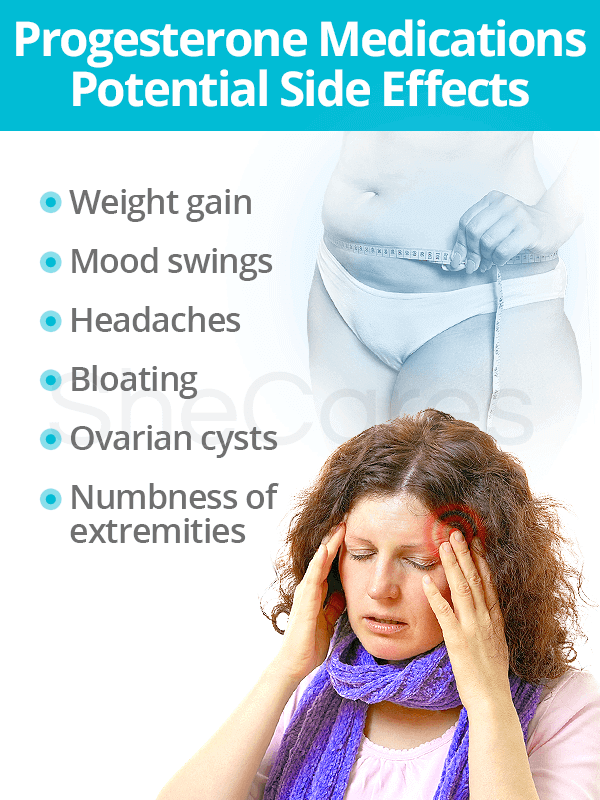Progesterone side effects are experienced when too much of the hormone is taken orally, applied topically, or inserted, thus saturating the glands. Continue reading to learn more about the safety and side effects of progesterone medications so that you can take a productive step toward optimal hormonal health
Progesterone Side Effects
Each of the progesterone medications has its specific list of side effects according to particular use. Also, it is essential to keep in mind that every woman will react differently to certain medications.
The extensive list of side effects of too much progesterone includes, but is not limited to, the following:
More Common:

- Weight gain
- Mood swings
- Headaches
- Irritation or pain at site of application or injection
- Bloating
- Drowsiness
- Dizziness
- Increase in blood pressure
- Cramping
- Acne
- Vomiting
- Insomnia
- Chest pain
- Breast tenderness or pain
- Muscle or joint pain
- Abnormal vaginal discharge or menstruation patterns
- Excessive hair (hirsutism)
- Cold or flu-like symptoms (chills, fever)
- Hives
Less Common:
- Clear or bloody discharge from the nipple
- Lump in the breast or under the arm
- Ovarian cysts
- Numbness of extremities
- Stomach pain
- Unexplained shortness of breath
- Depression
- Seizures
- Coughing up blood
- Slurred speech
- Confusion
- Swelling of ankles or feet
- Yellowing eyes and skin
- Blurred vision
- Blood clots
- Alopecia
- Stroke
- Gallbladder disease
- Heart disease
- Breast cancer
Safety of Progesterone Medications

In general, progesterone medications are safe to use with proper instruction. However, certain restrictions may apply for those who are pregnant or breastfeeding or for those with a history of heart or liver disease; stroke; or breast cancer.
In all cases, it is recommended to pursue check-up appointments every three to six months to monitor treatment effectiveness and adjust dosages as necessary.1
Nevertheless, to completely avoid the possible side effects of too much progesterone from taking exogenous hormone medications, explore natural progesterone supplements, specifically herbal options.
Sources
- Apgar, B.S. & Greenberg, G. (2000). Using Progestins in Clinical Practice. American Family Physician, 62(8), 1839-1846. Retrieved December 13, 2019, from https://www.aafp.org/afp/2000/1015/p1839.html
- Center for Young Women's Health. (2019). Estrogen/Progestin Hormonal Injections. Retrieved December 13, 2019, from https://youngwomenshealth.org/2011/07/01/hormonal-injections/
- Conrad, C. (2005). A Woman's Guide to Natural Hormones. New York: The Berkley Publishing Group. Available from Google Books.
- Mayo Clinic. (2019). Progesterone (Oral Route): Side Effects | Progestin (Oral Route, Parenteral Route, Vaginal Route): Side Effects. Retrieved December 13, 2019, from https://www.mayoclinic.org/drugs-supplements/progesterone-oral-route/side-effects/drg-20075298 | https://www.mayoclinic.org/drugs-supplements/progestin-oral-route-parenteral-route-vaginal-route/side-effects/drg-20069443
- Michigan Medicine. (2015). Progesterone vaginal. Retrieved December 13, 2019, from http://www.uofmhealth.org/health-library/d00550t1
Footnotes:
- Winchester Hospital. (n.d.). Hormone Replacement Therapy for Women (HRT). Retrieved December 13, 2019, from https://www.winchesterhospital.org/health-library/article?id=14451
